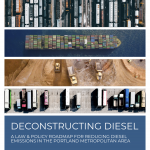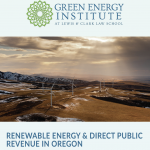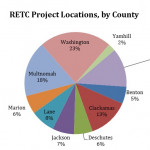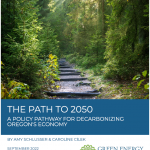Publications
-

NOTE: This Guide was published prior to the Ninth Circuit’s decision in California Restaurant Ass’n v. City of Berkeley, 65 F.4th 1045, 1048 (9th Cir. 2023), petition for reh’g en banc filed, No. 21-16278 (9th Cir. May 31, 2023). Many, but not all, of the pathways remain viable. Please contact us for further information.
GEI and Breach Collective published Regulating Natural Gas in Oregon’s Buildings: A Guide for Local Governments. The Guide offers ten strategies, and the legal feasibility of each, available to local governments in Oregon who seek to curb or prevent natural gas (methane) emissions. -
While Oregon has made significant progress, the state is not on track to achieve its climate targets. GEI has developed an economy-wide climate policy roadmap for Oregon that identifies a suite of laws and policies that will enable the state to achieve its climate goals in an equitable and economical manner.
It includes key policies for reducing transportation sector emissions, reducing electricity sector emissions, building emissions, industrial sector emissions, and cross-sector emissions.
Drafted by Amy Schlusser and Caroline Cilek, the report “is intended to reflect a balanced climate policy approach that is ambitious, cost-effective, equitable, and achievable.”
To view the full suite of policies included in our decarbonization policy pathway, we encourage readers to explore our pathway within the EPS model. Energy Policy Solutions, GEI Oregon Decarbonization Policy Pathway,https://energypolicy.solutions/simulator/oregon/en?s=xjggfr3z. The link will launch the Oregon EPS and download the GEI pathway. -

With the transportation sector rapidly shifting to electric vehicles, pressure is increasing in many states to reduce reliance on gas tax revenues as the primary source of highway funding. This impetus is particularly pronounced in Oregon, where the state’s reliance on gas taxes conflicts with the state’s ambitious climate goals. Unfortunately, Oregon’s constitution constrains the state’s authority to raise and spend motor vehicle-related revenues. GEI’s Building Bridges report provides a comprehensive analysis of article IX, section 3a of the Oregon Constitution and the restrictions it places on raising and using highway funds. The report explains how Oregon’s constitutional restrictions limit available pathways to raise revenue to advance equitable transportation decarbonization and respond to shifting transportation needs in Oregon. The report also provides a detailed legal analysis of the Oregon Supreme Court’s interpretations of the constitutional restrictions on and permissible uses of highway funds.
-

In the Portland metropolitan area, pollution from diesel-fueled vehicles and engines presents a significant risk to public health and causes temperature increases that contribute to global climate change. GEI’s Deconstructing Diesel Law & Policy Roadmap aims to help local governments and community stakeholders better understand the legal frameworks and regulatory limitations local governments must navigate to effectively address diesel pollution. The Roadmap presents a variety of strategies local governments can implement to reduce diesel pollution from on-road, nonroad, and indirect sources in Portland and surrounding Multnomah County.
-
 GEI’s Deconstructing Diesel Guide is a condensed version of our Deconstructing Diesel Law & Policy Roadmap, which aims to help local governments and community stakeholders better understand the legal frameworks and regulatory limitations local governments must navigate to effectively address diesel pollution at the local level. The Guide outlines a variety of strategies local governments can implement to reduce diesel pollution from local sources. This Guide is intended to provide a concise, user-friendly overview of the legal and policy issues surrounding diesel emissions regulation.
GEI’s Deconstructing Diesel Guide is a condensed version of our Deconstructing Diesel Law & Policy Roadmap, which aims to help local governments and community stakeholders better understand the legal frameworks and regulatory limitations local governments must navigate to effectively address diesel pollution at the local level. The Guide outlines a variety of strategies local governments can implement to reduce diesel pollution from local sources. This Guide is intended to provide a concise, user-friendly overview of the legal and policy issues surrounding diesel emissions regulation. -
 A brief three-page document on the potential pitfalls of incorporating banking without limits in a cap-and-trade program.
A brief three-page document on the potential pitfalls of incorporating banking without limits in a cap-and-trade program. -
 A PowerPoint Presentation presented to the Oregon Public Utility Commission (PUC) on January 31, 2019, by GEI director Melissa Powers. GEI encouraged the PUC to view PURPA as a tool to enable ambitious, innovative, efficient renewable energy development in the state.
A PowerPoint Presentation presented to the Oregon Public Utility Commission (PUC) on January 31, 2019, by GEI director Melissa Powers. GEI encouraged the PUC to view PURPA as a tool to enable ambitious, innovative, efficient renewable energy development in the state. -

Renewable energy projects provided Oregon counties more than $120 million in direct tax revenue over the past four years and nearly $32 million in tax year 2017-2018 alone. Rural counties in Oregon were by far the greatest beneficiaries of this revenue: in the 2017-2018 tax year, Sherman County received more than $12.5 million, Gilliam County received more than $8.5 million, and Umatilla, Morrow, and Malheur Counties each received around $2.5 million in direct tax payments from renewable energy projects. Read GEI’s Renewable Energy & Direct Public Revenue in Oregon to learn more about the effects of renewable energy development in Oregon.
-
 A Power Point presentation prepared by Professor Melissa Powers, GEI staff attorney Amy Schlusser, and GEI Energy Law Fellows Lev Blumenstein and Natascha Smith summarizing regulatory and policy recommendations to reduce harmful diesel emissions in the Portland metropolitan area. This research was presented to the public during a March 21, 2018 event, Deconstructing Diesel Happy Hour, co-hosted by Neighbors for Clean Air.
A Power Point presentation prepared by Professor Melissa Powers, GEI staff attorney Amy Schlusser, and GEI Energy Law Fellows Lev Blumenstein and Natascha Smith summarizing regulatory and policy recommendations to reduce harmful diesel emissions in the Portland metropolitan area. This research was presented to the public during a March 21, 2018 event, Deconstructing Diesel Happy Hour, co-hosted by Neighbors for Clean Air. -

Oregon has ambitious climate goals that call for the state to dramatically reduce its greenhouse gas emissions by 2050, and the state legislature and executive branch agencies have adopted a variety of climate and energy-related policies that aim to reduce Oregon’s climate impacts and support the transition toward renewable energy. Despite these efforts, however, Oregon is not currently on track to meet its long-term climate goals. GEI’s Taking Charge analysis explains why a comprehensive climate and energy governance framework is necessary to achieve meaningful progress in decarbonizing state and local economies, and presents a series of governance options that would support Oregon’s efforts to reduce emissions and transition to a clean energy system.
-
 Oregon’s Solar Future is a detailed background report on The Oregon Solar Plan, which establishes a blueprint for getting 10% of Oregon’s electricity from solar power in ten years. Oregon’s Solar Future provides an in-depth look at the current status of solar energy in Oregon and explains how the state can realistically deploy enough solar capacity to provide 10% of Oregon’s electricity by 2027.
Oregon’s Solar Future is a detailed background report on The Oregon Solar Plan, which establishes a blueprint for getting 10% of Oregon’s electricity from solar power in ten years. Oregon’s Solar Future provides an in-depth look at the current status of solar energy in Oregon and explains how the state can realistically deploy enough solar capacity to provide 10% of Oregon’s electricity by 2027. -
 Oregon can realistically get 10% of its electricity from solar power within the next ten years. GEI worked with the Oregon Solar Energy Industries Association to develop the Oregon Solar Plan, which establishes a blueprint for deploying 4 gigawatts of solar PV capacity in Oregon between 2017 and 2027—enough solar capacity to power 500,000 homes and provide 10% of the state’s electricity.
Oregon can realistically get 10% of its electricity from solar power within the next ten years. GEI worked with the Oregon Solar Energy Industries Association to develop the Oregon Solar Plan, which establishes a blueprint for deploying 4 gigawatts of solar PV capacity in Oregon between 2017 and 2027—enough solar capacity to power 500,000 homes and provide 10% of the state’s electricity. -
 GEI’s new analysis of Oregon’s Residential Energy Tax Credit shows significant benefits across Oregon and among different communities between 2013 and 2015.
GEI’s new analysis of Oregon’s Residential Energy Tax Credit shows significant benefits across Oregon and among different communities between 2013 and 2015. -

A GEI policy report evaluating the effectiveness of Oregon’s existing climate laws and recommending that Oregon adopt a comprehensive climate policy framework to enable the state to reach its greenhouse gas emissions reduction goals.
-

A GEI policy report by Amelia Reiver Schlusser assessing the grid reliability implications of the Clean Power Plan in the West, and recommending strategies to support reliability under high penetrations of variable renewable energy.
Green Energy is located in Wood Hall on the Law Campus.
email gei@lclark.edu
Director
Carra Sahler
Green Energy
Lewis & Clark Law School
10101 S. Terwilliger Boulevard MSC
Portland OR 97219


